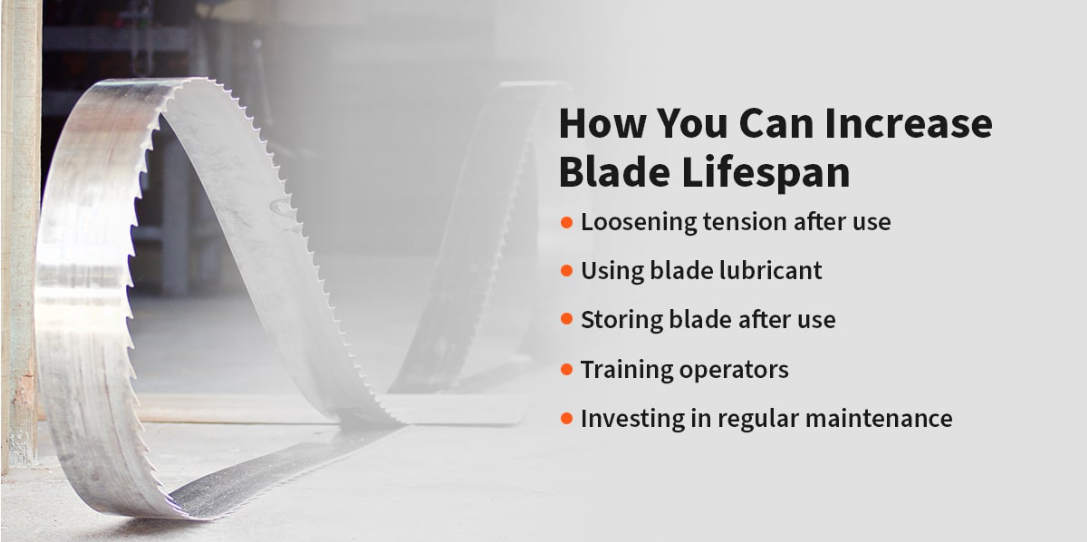How You Can Increase Blade Lifespan
When investing in a bandsaw blade to cut materials, there are many steps and habits you can incorporate into your bandsaw processes to increase and optimize its lifespan. Some things to consider include:
- Loosening tension after use: Good aftercare is essential when maintaining your bandsaw blade and helping it last longer with less wear. You can help ensure your blade fits well with its machinery and experiences less wear by loosening its tension after usage. While many blades require a specific tension, releasing it afterward can reduce strain, helping it last longer.
- Using blade lubricant: Bandsaw blades produce heat while working, putting additional strain on the blade and causing it to dull quicker. You can counter this by applying a blade lubricant or coolant on the blade before using it.
- Storing blade after use: In addition to loosening the tension, you can help prevent damages or wear by taking your blade off the machine and keeping it somewhere safe until its next use. You can safely remove the blade and turn it into tight curls, allowing you to store it and protect it from dirt, damage and wear until you need it again.
- Training operators: Bandsaw blades have particular requirements for tension levels, blade angles, speed, cleaning and materials you can use with it. You can help ensure its lifespan by providing all bandsaw operators with thorough training to help them understand the machine requirements and the steps they need to take to maintain performance and quality.
- Investing in regular maintenance: Bandsaws require regular maintenance to ensure they function at their desired level. Whether you further train employees to understand and carry out maintenance procedures or outsource to maintenance professionals, investing in the care of your equipment can help ensure it lasts.
Implementing these measures into your bandsaw practices can help you provide better care for your blades, helping increase their lifespan and long-term functionality.
Signs Your Bandsaw Blade Is Dull
Blades dull at a slow rate, making it challenging to identify when you might need to consider a replacement or repairs. Some signs that you are using a dull blade include:
- Losing teeth: If teeth start falling off the blade, that is a sign that it has reached the end of its lifespan and to invest in a new one.
- Increasing operating noise: Blades naturally make noises when functioning, but if you start to notice increases in noise or the presence of squeaking when operating, take that as your sign to consider a new blade.
- Increasing heat levels: Increasing heat can signify several problems with your bandsaw blade, from losing teeth to incorrect tension. Further, this is a sign of aging for blades, so it might be time to look for a replacement when heat increases.
- Decreasing accuracy: Bandsaws are great tools for making irregular or curved cuts in materials. However, if your blade has a more challenging time handling tasks or producing quality products, your blade might have reached its end.
Understanding the signs of a dull blade can help you know when to check the blade and look for problems. If you know what to look for, you can better address signs and continue to provide high-quality functionality.
Aging Bandsaw Blade Solutions
Depending on the problem with your bandsaw blade, you may be able to repair it. You can fix dents or sharpen the teeth to an extent to help extend the blade's lifespan. You can even manually sharpen teeth by carefully using a sharpening stone and file, though you will need to be sure you maintain the original angle of the teeth to maintain performance and functionality.
Knowing when to make repairs can help you save money on minor problems and fixes that are easier to accomplish. Especially if it is something you can fix yourself instead of outsourcing, you can extend your blade's lifespan while saving money.
However, some repairs might be too extensive or your blade might be reaching the end of its natural lifespan. You will still want to ensure the functionality of your equipment and the safety of your operators when assessing blade performance. Repairing might become more costly, time-consuming or create additional operational risks. Instead, knowing when to invest in new parts for your equipment is essential for maintaining process efficiency and preventing unnecessary costs or risks.
Invest in Long-Lasting Bandsaw Blades With DoALL Sawing Products
While many factors affect blade longevity and steps you can take to increase the lifespan, investing in quality bandsaw blades is the first step in ensuring quality, long-lasting equipment. Further, choosing a company that provides extensive services can help you maintain your blades for even longer lifespans.
DoALL Sawing Products designs and produces high-quality metal bandsaw blades and accessories, like blade coolant, so you can experience increased functionality and performance when cutting metal.
Previously Featured on DoALL's blog.





Talk to Us!
Leave a reply
Your email address will not be published. Required fields are marked *